A unusual number of named artists who were active in the 12th and 13th centuries are known to have come from Spoleto or to have worked here.
Alberto Sotio
Spoleto
Christus Triumphans (1187)
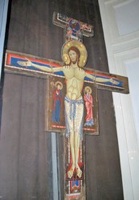
The inscription at the foot of the cross gives the name "Alberto So.." and the date in Roman numerals. The signature is usually presumed to be that of the artist, who is referred to as Alberto Sotio. If this is correct, this is one of the earliest surviving works of art that bears the date and the name of the artist.
Christ is depicted on the cross with his eyes open, apparently impervious to his pain, as is usual before the 13th century. Full length figures of the grieving Virgin and St John the Evangelist stand to the sides.
-
✴There is an interesting representation of the Ascension of Christ above the cross, in which angels carry Him to Heaven in a mandorla.
-
✴The hills of Golgotha are represented below the cross, and blood from the wounds in Christ's feet flows into the mouth of a skull of Adam.
Martyrdom of SS John and Paul (late 12th century)
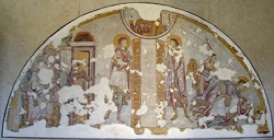
This important fresco, which is attributed to Alberto Sotio, was detached from the crypt of SS Giovanni e Paolo in 1961 and is now in Room 9 of the Museo Nazionale del Ducato di Spoleto:
-
✴To the left, the Emperor Julian the Apostate orders the brothers' execution.
-
✴To the right, they are beheaded.
-
✴In the centre, they stand at the gates of Heaven, with Christ in judgment above.
Simone and Machilone (died after 1258)
These artists are know from three signed works:
-
✴A panel (now lost) with the signature “SIMEON ET MACHILON SPOLETANI ” and the date 1230 was documented in the Duomo of Ancona until 1728.
-
✴A dossal in the Mayer van den Bergh Museum, Antwerp is signed “SYMEON’ ET MACHILON’ SPOL” and dated 1258. It depicts the Madonna and Child enthroned with four narative scenes: the birth of the Virgin, the Annunciation; the Nativity; and the Assumption of the Virgin.
-
✴A damaged painted crucifix in Palazzo Barberini, Rome is signed “SYMEON ET MACHILO... .
Otricoli
Madonna and Child (13th century)
This altarpiece in Santa Maria Assunta (the Cappella della Madonna della Misericordia, to the right of the presbytery) is attributed to Simeone and Machilone. It was stolen in 1978 but subsequently recovered, and has recently been restored.
Orvieto
The following are in the Museo dell’ Opera del Duomo, Orvieto:
Madonna and Child (13th century)
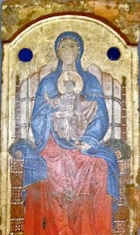
The icon depicts the Madonna and Child enthroned. The "Child" is represented as an adult wearing a toga: He holds the Gospel in His left hand and raises His right hand in blessing.
Crucifix (13th century)
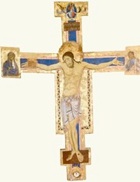
Rainaldo di Ranuccio
This artist is known from two signed painted Crucifixes, both of which employ the iconography of Christus Patiens;
-
✴one in the Pinacoteca Comunale, Fabriano, which is signed by [RA]NALDICTUS RA[N]UCI DE SPOL[ETO] (listed in this page as Rainaldetto di Ranuccio); and
-
✴one in the Pinacoteca Nazionale, Bologna, which is signed MAGISTER RAINALDO RANUCII and dated 1265.
Spoleto
[Are there any works in Spoleto attributed to him ??]
Assisi
Historiated Triptych (ca. 1270)
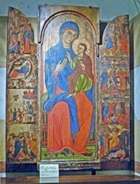
Montefalco
Christus Patiens (late 13th century)
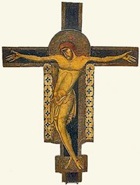
The ancient church of Santa Maria della Selva Mattutina was first documented in 1334 as the home of a dissident Franciscan community that was accused of heresy. It was documented again in 1466, when it belonged to the now-recognised Franciscan Third Order Regular (Fraticelli). The Fraticelli of San Rocco, Montefalco moved there in 1526, and it became the only surviving convent belonging to this branch of the Order in Umbria soon after, when Santa Caterina di Rapicchiano, near Spello and San Lorenzo di Foligno closed. It seems likely that the Crucifix had a Franciscan provenance, and that it passed into the ownership of one of these communities of Fraticelli, perhaps those from San Rocco.
Solsternus
Spoleto
Deesis (1207)
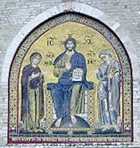
The mosaic has been restored on a number of occasions, including in 1927, when the head of St John the Baptist had to be replaced. The most recent restoration was carried out in 1976.
Return to the page on Art in: Assisi Montefalco Orvieto Otricoli Spoleto.



